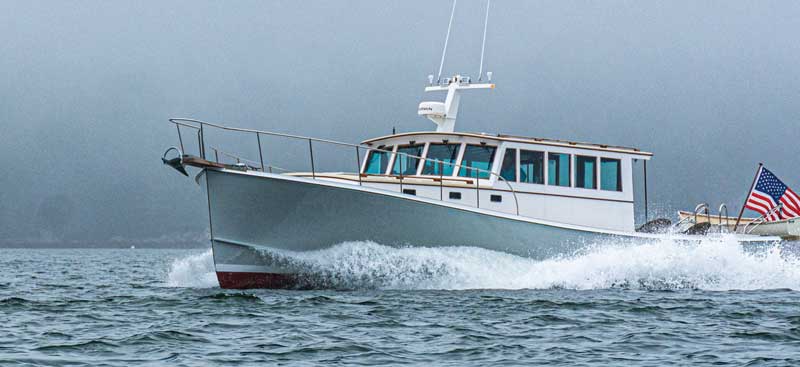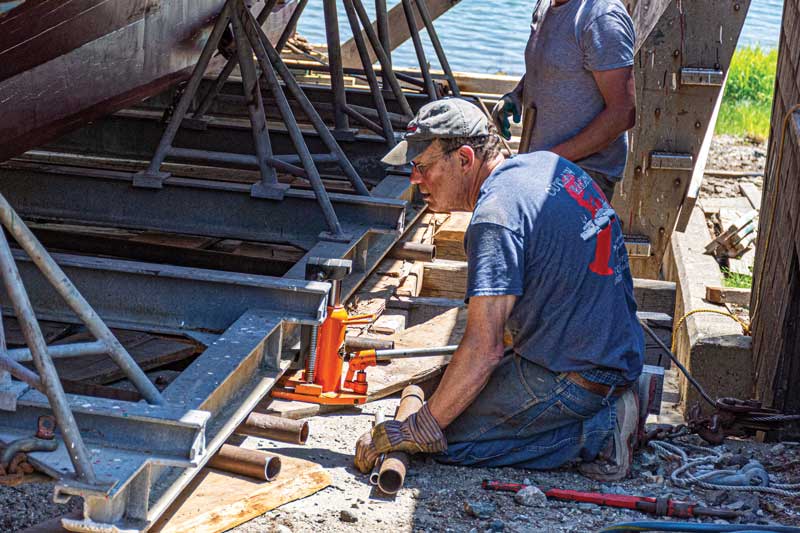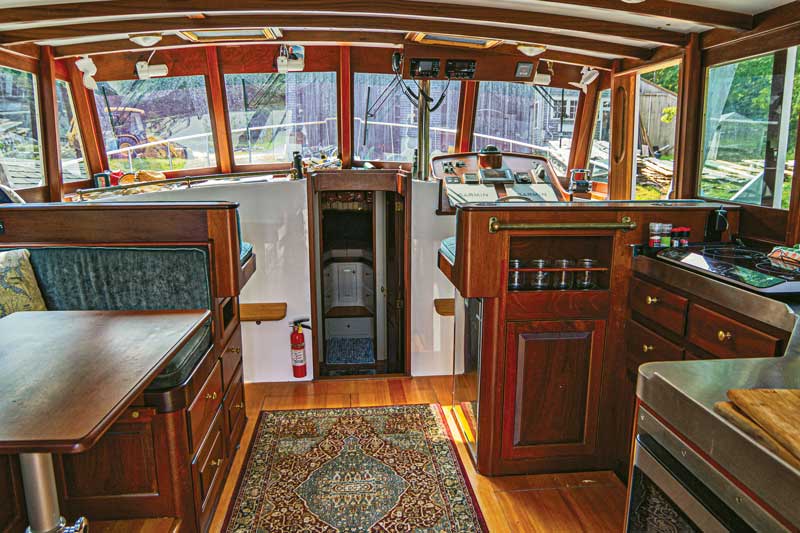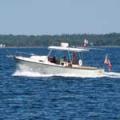John’s Bay Boat Company
40-Plus Years of Doing It Right
All photos by Walt Barrows
 Vigilant: a 44-foot-6-inch by 14-foot-2-inch example of what John’s Bay Boat Company does—build pretty wooden boats.
Vigilant: a 44-foot-6-inch by 14-foot-2-inch example of what John’s Bay Boat Company does—build pretty wooden boats.
Many years ago, a well-meaning journalist used the phrase “Cadillac lobsterboat” to describe a new build by John’s Bay Boat Company. The tag was definitely meant as a compliment, referring to the workmanship the South Bristol shop puts into every one of their wooden boats—no matter how simple or how elaborate—but one has to wonder if some potential customers interpreted it as a “Cadillac” price tag.
The reality is, John’s Bay owner Peter Kass has probably never charged enough for his boats, which have always been in the ballpark dollar-wise of custom-finished fiberglass boats in the same size range. From basic lobsterboat to tricked-out cruiser—of which the recently launched 44-foot Vigilant is a prime example—John’s Bay does beautiful work. It’s as simple as that.
So, where did Kass’s skills, work ethic, and dedication to his craft come from?
Tracing his roots back, you’re not going to find any stories of a young rosy-cheeked lad towing whittled-out wooden boat models along the shore, gazing down the bay with a faraway look in his eye, and vowing to make his mark in the boatbuilding world someday. Nope, none of that.
“I was a lousy student; I really hated school,” said Kass, talking about growing up in Arlington, Massachusetts. “It got to the point where the guidance counselor sat me down and asked, ‘What are you interested in?’
“I’d seen an ad somewhere for a boatbuilding school in Virginia and got it in my head that I’d like to try that. It so happened that my guidance counselor knew a counselor down in Virginia who did some asking around. One of the local boatbuilders down there told him, ‘Aw, that school isn’t what he’s looking for. Send him down to work for me and I’ll teach him what he wants to learn!’
“So,” Kass said, “spring of my senior year in ’77, I headed down to Urbanna, Virginia. Once I got there, I figured out what was going on: That guy had a whole crew there of kids like me, who all wanted to learn about boatbuilding, and hired them on for minimum wage. It was great—for him!”
Home for Christmas in December of that year, Kass made a pilgrimage north to Maine, “because everyone said, ‘If you’re going to get into boatbuilding, Maine’s where it’s at.’”
The trip bore fruit. Kass joined the woodworking crew at Gamage Shipyard in South Bristol, Maine, which was just starting the 86-foot Appledore II. It turned out to be the last wooden project launched by the yard; it hit the water in August, 1978.
Wanting to remain in the world of wood, Kass spent the next couple of years at Goudy & Stevens in Boothbay doing repair work on boats that customers had hauled out on the yard’s marine railway, then joined Padebco in Round Pond, which was still doing some wooden projects at the time.
Meanwhile, Kass began doing some moonlighting, tackling various wooden boat projects (including a string of peapods he built from scratch) on his own time.
The after-hours side projects began to escalate and Kass soon realized that his best chance to work in an exclusively wood boat shop was to start one of his own. When a piece of land in South Bristol became available, Kass bought it and invested his nights and weekends into turning it into a working boatshop, complete with a railway for both new launches and handling repairs and yearly maintenance for customers. In the fall of 1983, John’s Bay Boat Company was open for business.
The first few years’ worth of from-scratch new builds from John’s Bay were birthed from designs from the late Carroll Lowell. It wasn’t until 1994, when the workboat market began leaning toward beamier, bulkier hulls with expanded work decks that Kass did his own full-size lobsterboat design: the 41-foot Acadia for Mike Campbell of Plymouth, Massachusetts.
“It was definitely what the market wanted at the time,” said Kass. “And we were definitely behind the trend compared to the fiberglass guys, but we went with it. Customers wanted to put bigger engines in, but still be able to shove them far forward. If we were going to continue to build boats, it’s what we had to do.”
 Using steel rollers and hydraulic jacks, Pete Kass and the John’s Bay crew inch Vigilant from the boat shop to the railway.
Using steel rollers and hydraulic jacks, Pete Kass and the John’s Bay crew inch Vigilant from the boat shop to the railway.
Over the years, Kass has worked with his customers to design and build what they’re looking for, and there are a number of repeat John’s Bay customers out there for that very reason.
Richard Armstrong, owner of the recently launched Vigilant, is actually a threepeat John’s Bay owner. And all three boats are still in the clan, with the first two now owned by his daughters’ families.
The first Kass-built boat for Armstrong, who hails from Westport, Massachusetts, was a used 40-footer with a 13-foot beam. “The original model for that one came from a 36- by 13-foot lobsterboat we’d built,” said Kass. “We had a customer who wanted something longer with the same beam and less flare...he wanted it to ‘look old.’”
Armstrong’s next boat was built new by John’s Bay. It was a 42-foot by 13-foot-6-inch design, which Richard loved. “He ended up just wanting a little more room,” said Kass, who describes Armstrong as “the nicest kind of a guy to build a boat for.”
Which brings us to Vigilant, a 44-foot-6-inch by 14-foot-2-inch built-down Kass design that narrows gently to 13 feet, 4 inches on the transom and draws approximately 5 feet, 8 inches. Her lines are typical of the more recent John’s Bay builds (even for the workboats): more slender beams and longer waterline lengths, making for economical performance.
Vigilant’s hull construction is standard John’s Bay specs: 1 1⁄4-inch cedar planking on 1 1⁄2-inch by 2 1⁄2-inch oak ribs, tied into a 7-inch oak keel.
Billings Diesel & Marine in Stonington provided the 44-footer’s power package: an 800-hp MAN matched to a 2.5:1 ZF 500-1A electronically-shifted gear (with ZF SmartCommand control heads). The MAN’s muscle is channeled through a two-and-a-half-inch driveline built by R.E. Thomas Marine Hardware back to a 36-inch-by-38-inch four-bladed prop from Nautilus Marine Fabrication. A pair of 300-gallon fuel tanks feeds the inline 6-cylinder MAN.
Sharing space in the engine compartment is a bank of lithium-ion batteries, a first for John’s Bay.
“On one hand, it’s a complicated system,” said Kass. “There’s definitely a lot to the hook-up. On the other hand, Rich can run everything he’s wanting to without the noise of a generator.”
Wiring for the project was done by Coastal Marine Wiring, with an electronics package supplied by Navtronics. Metal fabrication was split between John’s Bay and Blue Water Fabrication.
 Vigilant’s wheelhouse interior features handsome woodwork with a fathoms-deep varnish finish.
Vigilant’s wheelhouse interior features handsome woodwork with a fathoms-deep varnish finish.
The interior layout (featuring the fathoms-deep varnish work typical of a John’s Bay) will make for comfy cruising, from the well-appointed galley and lounge area in the wheelhouse to the accommodations below, which include a double bunk in the main cabin and V-berths forward.
Overboard and ready to go with her tanks topped off, Vigilant tops out at 24 knots with an easy 17-knot cruise at 1,700 rpm.
All in all, it’s an impressive package, whether you’re focused on Vigilant’s lines, the craftsmanship of the woodwork, or the engineering that went into the various systems and making everything fit and work.
For Peter Kass and crew, it’s what they do: Number 77 is just the latest in a long line of handsome wooden boats.
✮
Vigilant Specifications
LOA: 44' 6"
Beam: 14' 2"
Draft: 5' 8"
Power: 800-hp MAN diesel
Top speed: 24 knots
Builder:
John’s Bay Boat Company
South Bristol, ME
207-644-8261
johnsbayboatcompany.com
Brian Robbins is senior contributing editor for Commercial Fisheries News, and is a former offshore lobsterman.
Related Articles
Share this article:
2023 Maine Boat & Home Show

Join Us for the Maine Boat & Home Show!
Art, Artisans, Food, Fun & Boats, Boats, Boats
August 11 - 13, 2023 | On the waterfront, Rockland, Maine
Click here to pre-order your tickets.
Show is produced by Maine Boats, Homes & Harbors magazine.















